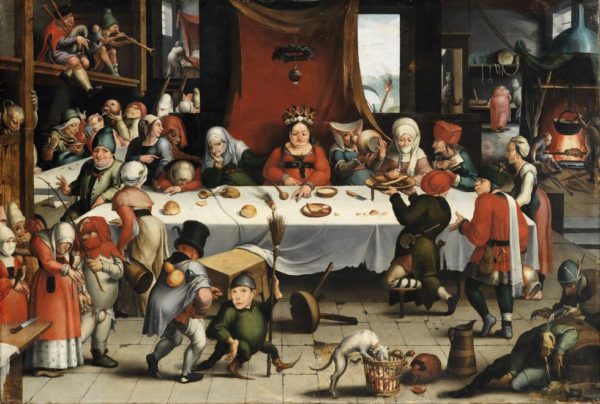
You see before you a picture that seems to be depicting a wedding feast. I say seems to be, because the title of the picture doesn’t say anything about a wedding. But, the order of those seated, the unhappy lady in the center, in front of a red cloth, wearing a crown with a wreath over her head are all reminiscent of other pictures from the same period that showed wedding feasts. This is ‘Burlesque Feast’ by Frans Verbeeck. This picture pulls you in and drags you down. It conjures up torrents of questions that seasoned art historians may be able to answer quickly, but maybe even the experts wouldn’t know. Allow me to show you around…
First, a little background. Frans Verbeeck (1510-1570) came from a family of important artists in Mechelen, in the province of Antwerp in the Flemish Region of Belgium. According to Wikipedia it is not always possible to attribute work to one or another of the Verbeeck family, but at least three paintings have been attributed specifically to Frans Verbeeck who lived in the middle of the 16th century.
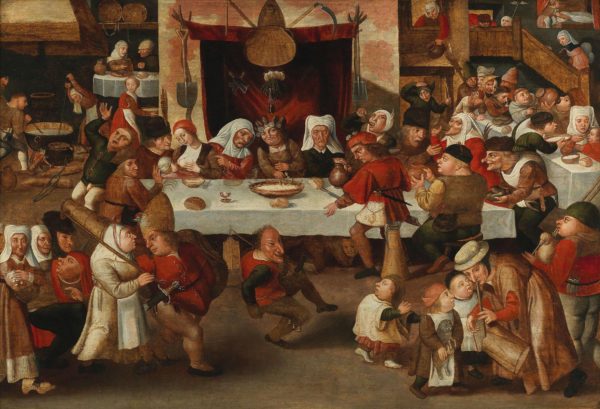
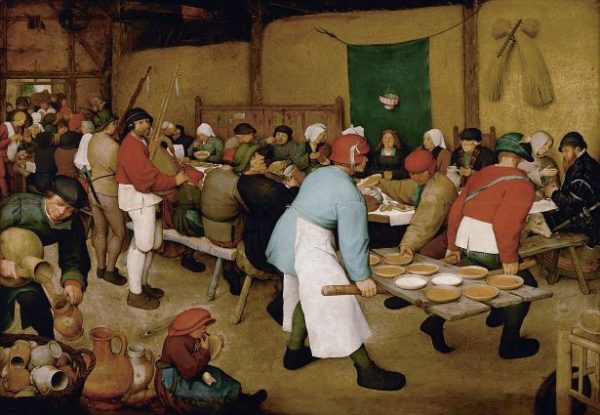
Burlesque Feast is not Frans Verbeeck’s most noted work. I found much more attention paid to The Mocking of Human Follies, and there is another feast picture attributed to Frans Verbeeck called ‘Peasant Wedding’ that looks very similar in composition albeit less strange. It is almost like ‘Burlesque Feast’ is making fun of ‘Peasant Wedding.’ And Verbeeck’s ‘Peasant Wedding’ in turn, almost seems to be making fun of Bruegel the Elder’s ‘Peasant Wedding’.
Plenty of analysis has gone into Bruegel the Elder’s ‘Peasant Wedding’ that can help us figure out what is going on in the other two pictures, even though the customs are unknown to us. For instance, the lady sitting in front of the green cloth, wearing a crown with a ‘crown’ suspended over her head is the bride. So, the characters similarly positioned in Verbeeck’s ‘Peasant Wedding’ and also in ‘Burlesque Feast’ are also brides, or playing the part of one.
Back to ‘Burlesque Feast.’ Go ahead and open the link to the large image on Wikimedia commons and get deep in there. Do you notice how the bride in front of the red cloth, wearing a crown that appears to be made of spoons and broken egg shells, under a wreath that hangs from the ceiling, looks so utterly unhappy? Maybe she looks so sad because her groom is the fellow in the bottom right retching into the corner? But her emotional state and his apparent drunkenness are nothing compared to other things happening in the picture.
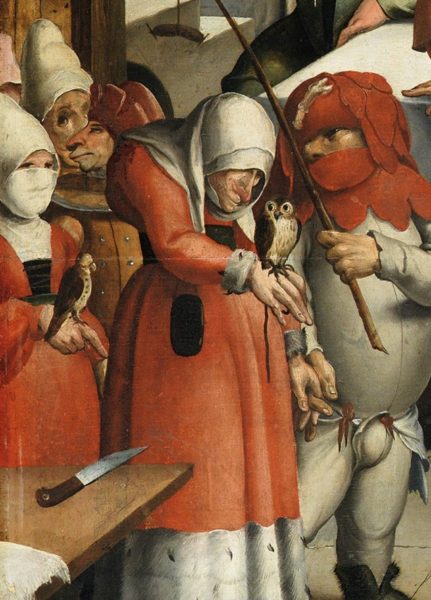
Coming in on the bottom left of the picture we see a procession of hooded figures seemingly lead by an elderly lady. From the ermine trim on her clothes and the owl on her hand – as well as the falcon on the hand of the lady behind her – I am guessing that these are quite well-to-do individuals. Falconry being a past-time of the rich. Perhaps these are the wealthy members of the town coming to give their blessing to the unhappy bride? But, look how odd and hunched the old lady is. Why is she so crooked. And why is there an unsheathed knife pointed at her on the table to her side? In Dutch still life painting, a popular art of the same time, a knife left carelessly on the table is a sign of betrayal. Is the old wealthy lady betrayed or the betrayer?
Owls in the middle ages were alternately seen as symbols of the devil or classically as representations of wisdom. Which could it be here?
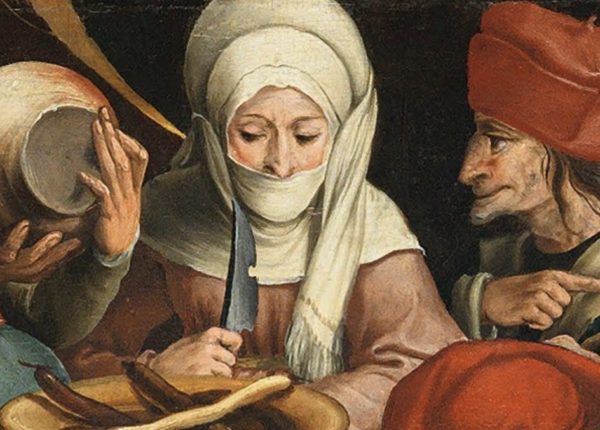
This lady, to the right of the bride (from our view), why does she look as though she is psyching herself up to stab a body? Is it the man who leans closely in to talk with her that has pushed her to this point of anger or the woman chugging from a jug on her other side? Or, is it just that she is dismayed her knife has a big ole’ nick out of the blade?
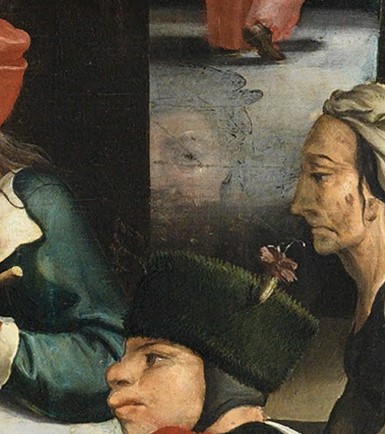
And further right, on the other side of the man that leans in closely, is a ghostly image of a man who is not there. He stares directly at the audience and is, in fact one of only two characters in this whole picture that do engage with the audience directly. Is this a mistake of the digitization process, or the painting actually have this ghostly image in it? If in the painting, it seems oddly deliberate. I know many paintings were painted on top of previous compositions, but this doesn’t look like an under-layer peeking through to me. If anything, it looks like the impression you might get if you had two printouts face to face in a folder for too long and a little of one gets stuck onto the other.
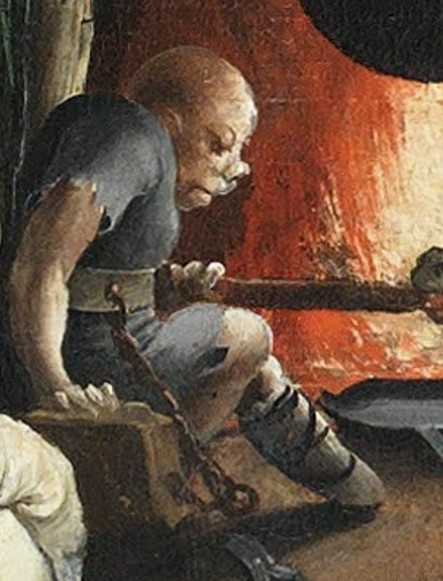
Further back in the room on the right side of the painting, a bald creature with a pig like nose tends a spit that cooks a cow head over the fire. That could be odd enough on its own, but as I looked at the figure, trying to see if he was missing a foot or it was just turned to the side (I vote for turned), I noticed that he is chained to a block. Slavery was present in Europe in the middle ages and there were also some interesting punishment devices, so is this creature enslaved or is it being punished?
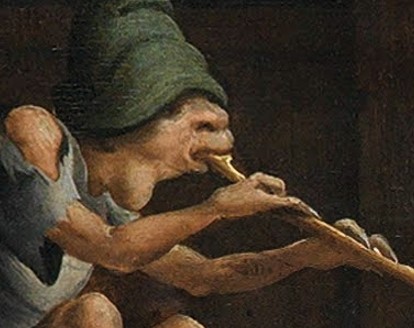
His is not the only face that is more creature-like than human-like. Up in the left hand corner, among other musicians playing for the feast is a flute player who looks, to me, like a lizard with a goiter. At first I was thinking that classifying some of the characters of the picture as creatures was a little harsh, but a closer look at the lizard like flute player reveals that he only has to fingers on each hand.
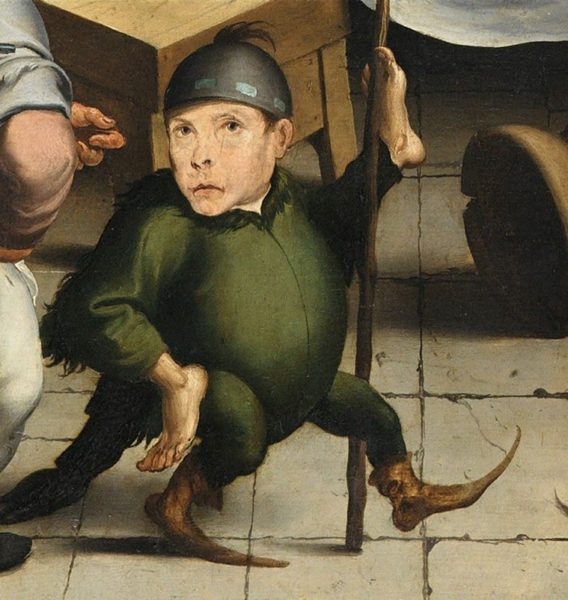
And finally, the most obvious but easy to overlook creature is front and center, across the table from the bride and the second character who engages us directly, or maybe the first. He has feet for hands, and, perhaps, a tail? I could also mention that he brandishes an upturned broom that holds a lit candle – something that is not safe in the least – but why dwell on that when he has feet for hands?
When I started looking at the other wedding pictures, I did notice in Verbeek’s ‘Peasant Wedding’ this spot in the picture is taken by a small jester-like human character. This is really what got me thinking that ‘Burlesque Feast’ was poking fun at ‘Peasant Wedding.’ The more I looked at Verbeek’s ‘Peasant Wedding’ I wondered if it was poking fun at Bruegel the Elder’s ‘Peasant Wedding.’ Bruegel’s picture was dated to 1567. I could not find if Verbeek’s pictures had been dated, but Verbeek and Bruegel were contemporaries, so I imagine some painterly teasing is possible.
